This homemade Dak Galbi recipe is inspired by the vibrant streets of Korea with a tantalizing and spicy stir-fried chicken dish. Bursting with bold flavors and an array of colorful vegetables, this savory delight is a perfect fusion of sweet, savory, and spicy notes. As you savor each tender bite of marinated chicken, you’ll experience the authentic taste of Dak Galbi right in the comfort of your own kitchen, bringing the spirit of Korean street food to your dining table.
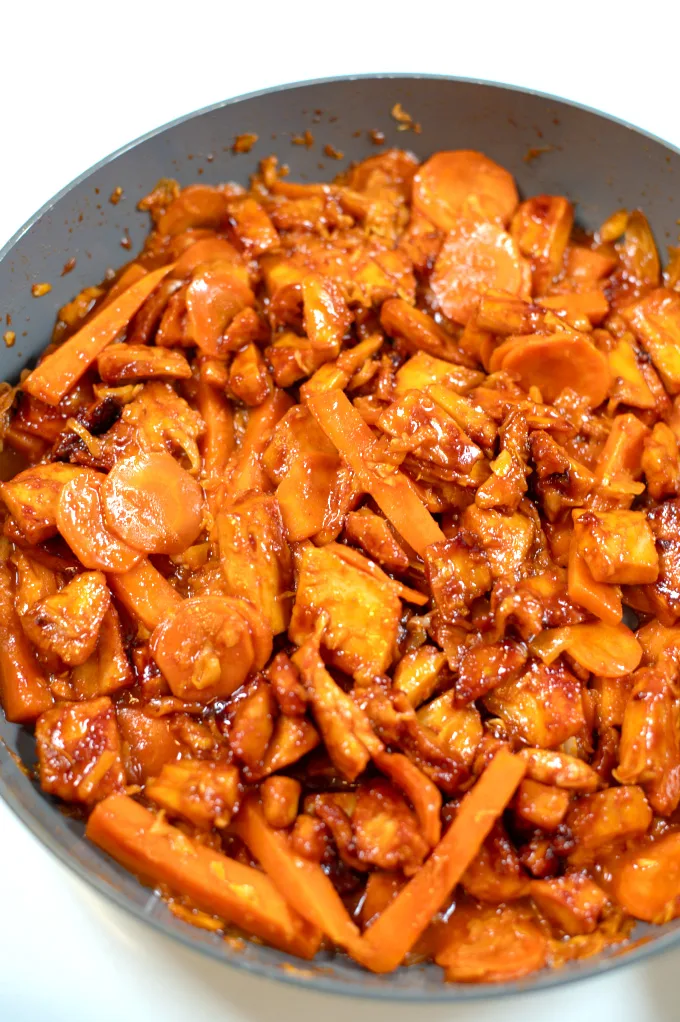
What is Dak Galbi made of?
Dak Galbi is a popular Korean dish primarily made with marinated chicken, typically boneless chicken thighs or breast, that is stir-fried in a flavorful sauce.
The marinade often includes a combination of ingredients like gochujang (Korean red chili paste), soy sauce, mirin (rice wine), garlic, ginger, and sugar. The dish is then cooked with a variety of vegetables such as cabbage, sweet potatoes, carrots, and scallions (green onions), creating a colorful and well-balanced ensemble.
The Dak Galbi recipe is known for its spicy kick, but variations in spice levels can be adjusted according to personal preference. Additionally, some recipes may include rice cakes or tteok, adding a delightfully chewy texture to the dish.
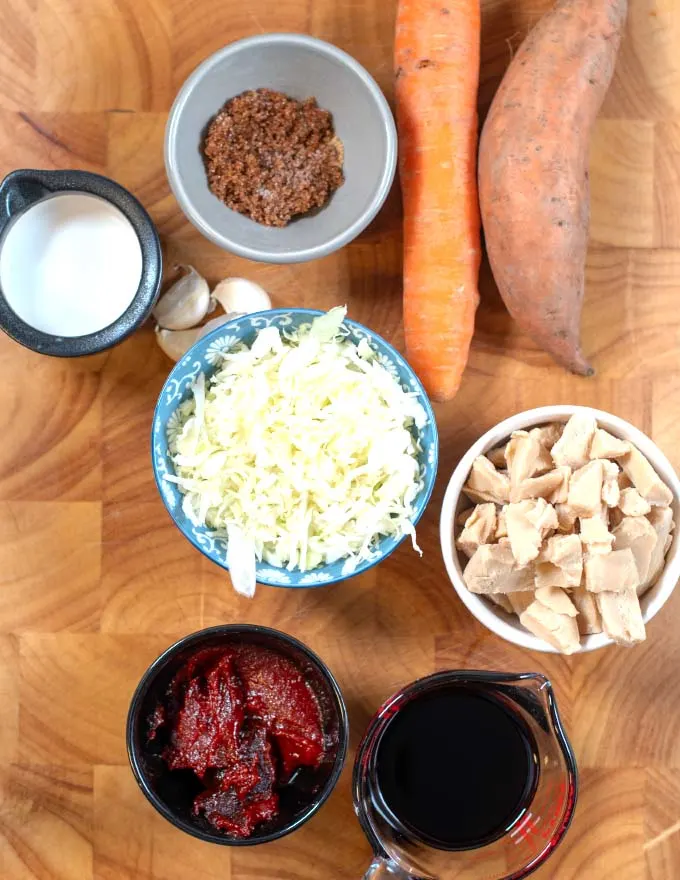
What is the difference between Dak Galbi and Buldak?
Dak Galbi and Buldak are both Korean chicken dishes, but they differ in terms of preparation, flavor profiles, and spiciness.
Dak Galbi is a stir-fried chicken dish where marinated chicken is cooked with a variety of vegetables in a spicy-sweet sauce. The sauce typically includes ingredients like gochujang (Korean red chili paste), soy sauce, garlic, ginger, and sugar. The dish is known for its vibrant and well-balanced flavors, combining the heat of the chili paste with the sweetness of the marinade.
On the other hand, Buldak, often referred to as “fire chicken,” is a dish specifically known for its intense spiciness. It involves chicken pieces, usually boneless, that are heavily coated in a fiery sauce made with gochugaru (Korean red chili flakes), gochujang, soy sauce, honey, and other seasonings. Buldak is renowned for its extremely spicy kick, making it a favorite among those who enjoy a serious heat challenge.
In summary, while both dishes feature chicken and spicy elements, Dak Galbi is a stir-fried dish with a balanced flavor profile, while Buldak is known for its intense spiciness and is often enjoyed by those who crave a more fiery culinary experience.
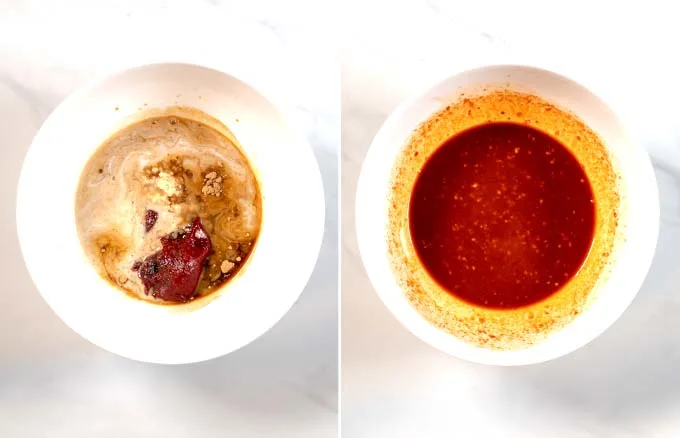
How do you eat Dak Galbi?
Eating Dak Galbi is a delightful and interactive experience. Here’s a simple guide on how to enjoy this Korean dish:
Dak Galbi is typically served with an array of side dishes, including fresh lettuce leaves or perilla leaves (sesame leaves), which act as wraps for the cooked chicken. These leaves add a refreshing and crisp element to each bite.
Customize your Dak Galbi recipe by using condiments like ssamjang (a thick, spicy paste made from fermented soybean and chili paste), garlic cloves, or sliced green peppers. These add extra layers of flavor to your wraps.
Take a piece of the cooked chicken, place it in a lettuce or perilla leaf, and add a small dollop of ssamjang, and any other condiments of your choice. Fold the leaf into a wrap or roll, creating a delicious and portable bite.
Enjoy Dak Galbi with traditional Korean side dishes such as kimchi, pickled radishes, or a small bowl of steamed rice to complement the flavors.
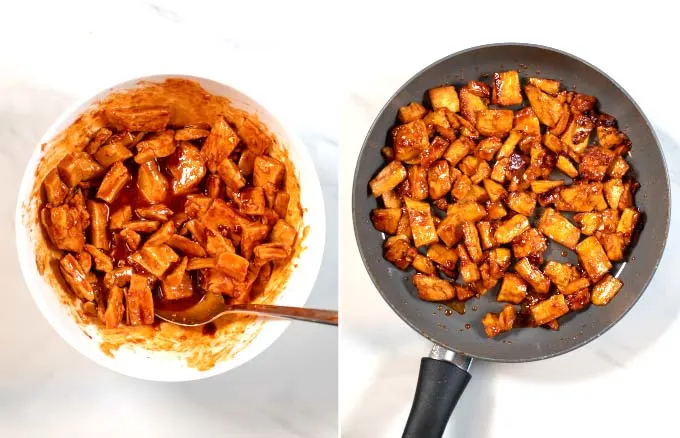
Why do Koreans put sugar in their food?
Sugar is commonly used in Korean cuisine for several reasons, contributing to the diverse and balanced flavor profile that characterizes many Korean dishes:
- Balancing Flavors: Sugar is often used to balance and round out the flavors in a dish. It can help offset the heat from spicy ingredients like gochujang (red chili paste) or gochugaru (red chili flakes) commonly found in Korean cuisine. The addition of sugar can create a harmonious blend of sweet, savory, and spicy notes.
- Enhancing Marinades and Sauces: Sugar is a key ingredient in many Korean marinades and sauces. For example, in dishes like Bulgogi (marinated and grilled beef) or Dak Galbi (spicy stir-fried chicken), use of sugar creates a flavorful and caramelized coating on the meat.
- Preserving and Pickling: Sugar is used in traditional Korean pickling and preserving methods. It helps create a balance of flavors in pickled vegetables and fruits, contributing both sweetness and a hint of acidity to the final product.
- Cultural Preferences: Korean cuisine often features a combination of sweet and savory elements, and the use of sugar aligns with the Korean palate’s preference for diverse flavor profiles. This balance of flavors is a distinctive characteristic of Korean cooking.
- Versatility in Desserts: Beyond savory dishes, sugar is a key ingredient in many Korean desserts. Popular treats like rice cakes (tteok) and sweet pancakes (hotteok) showcase the versatile use of sugar in creating delightful and sweet culinary experiences.
While sugar is used in various Korean dishes, it’s important to note that not all Korean recipes incorporate sugar, and the use of sweetness can vary based on regional differences, individual preferences, and the specific dish being prepared.
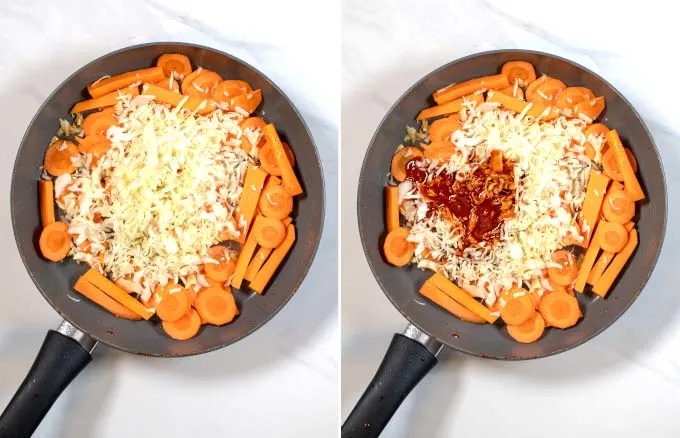
What ingredients do I need for this homemade Dak Galbi recipe
If you are looking to prepare a delicious and flavorful homemade Dak Galbi dish, you will need the following ingredients:
- 1 cup of sweet potatoes, which will add a natural sweetness to the dish.
- 2 tablespoons of vegetable oil or sesame oil, divided, for frying the vegetables and the vegan chicken.
- 1/3 cup of cabbage, which will provide a crunchy texture and a mild flavor.
- 10 ounces of vegan chicken, which will provide a protein-rich and meaty texture to the dish.
- 1/2 cup of carrots, which will add a sweet and earthy flavor to the dish.
- Salt and black pepper to taste, to enhance the flavors of the dish.
To make the sauce and marinade, you will need the following sauce ingredients:
- 2 tablespoons of Gochujang paste, which is a spicy and savory Korean chili paste.
- 2 tablespoons of coconut milk, which will add a creamy and sweet flavor to the sauce.
- 2 tablespoons of brown sugar, which will provide a hint of sweetness and balance out the spiciness of the Gochujang paste.
- 3 cloves of garlic, which will add a fragrant and pungent flavor to the sauce.
- 3 tablespoons of soy sauce, which will add a salty and savory flavor to the sauce.
- 1 teaspoon of ginger, which will add a warm and spicy flavor to the sauce.
- 3 tablespoons of rice vinegar, which will add a tangy and slightly sweet flavor to the sauce.
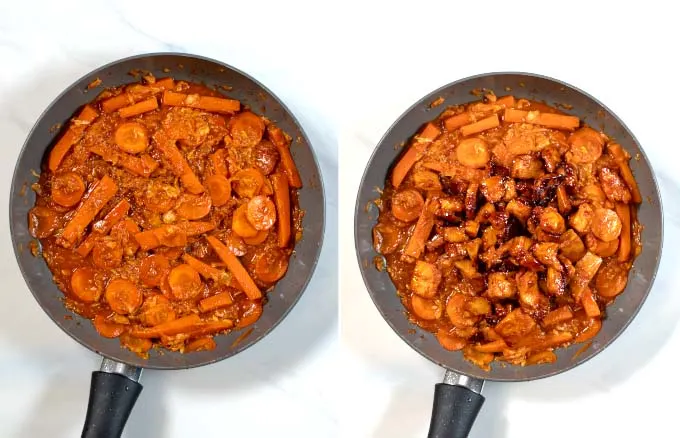
How to Make Dak Galbi:
Marinate the chicken:
In a bowl, combine gochujang paste, soy sauce, rice vinegar, sugar, garlic, ginger, and coconut milk. Mix until well combined.
Add the chicken to the marinade and let it marinate for 10 minutes.
Cook the chicken:
Heat a large skillet with 1 tablespoon of vegetable oil. Add the chicken (don’t discard the remaining sauce) and cook for about 5 minutes. The cooking time will depend on the package directions.
Remove the chicken from the pan.
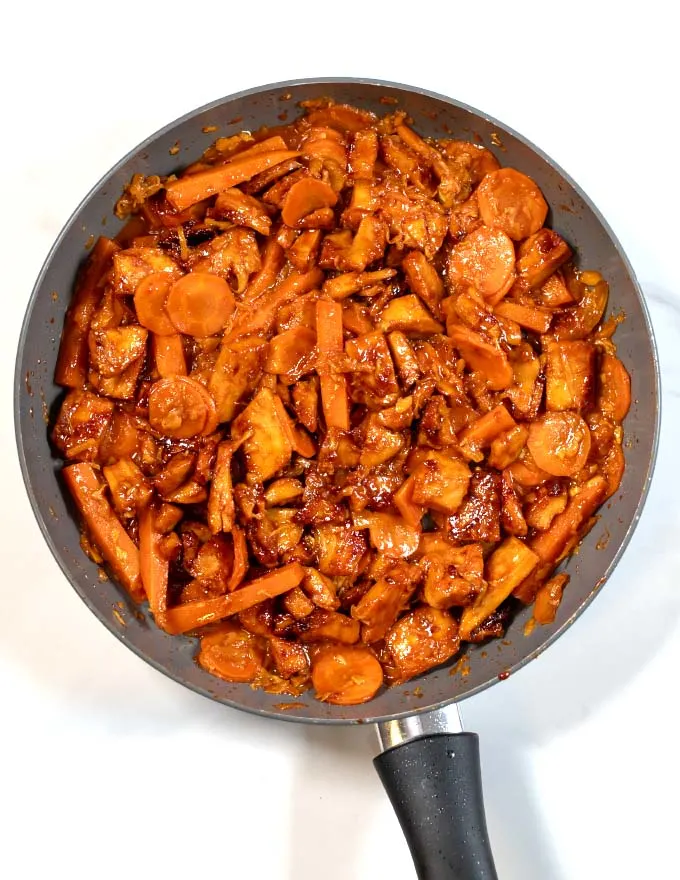
Cook the vegetables:
In the same pan, add another tablespoon of oil, sweet potatoes, carrots, cabbage, and the remaining sauce. Cook for 15 minutes.
Add the chicken back to the pan and cook for an additional 2 minutes.
Serve and enjoy!
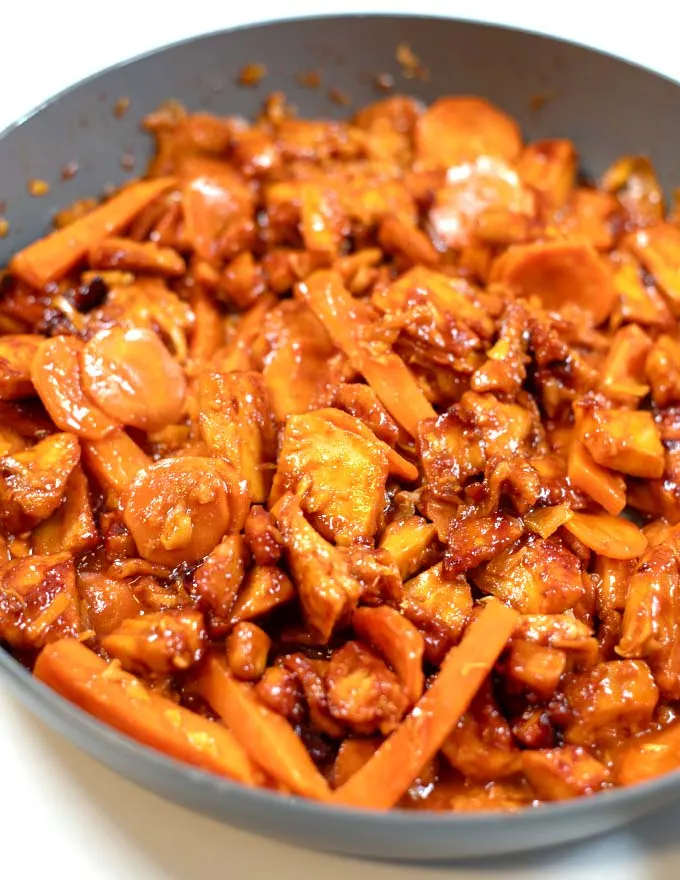
Other recipes to try
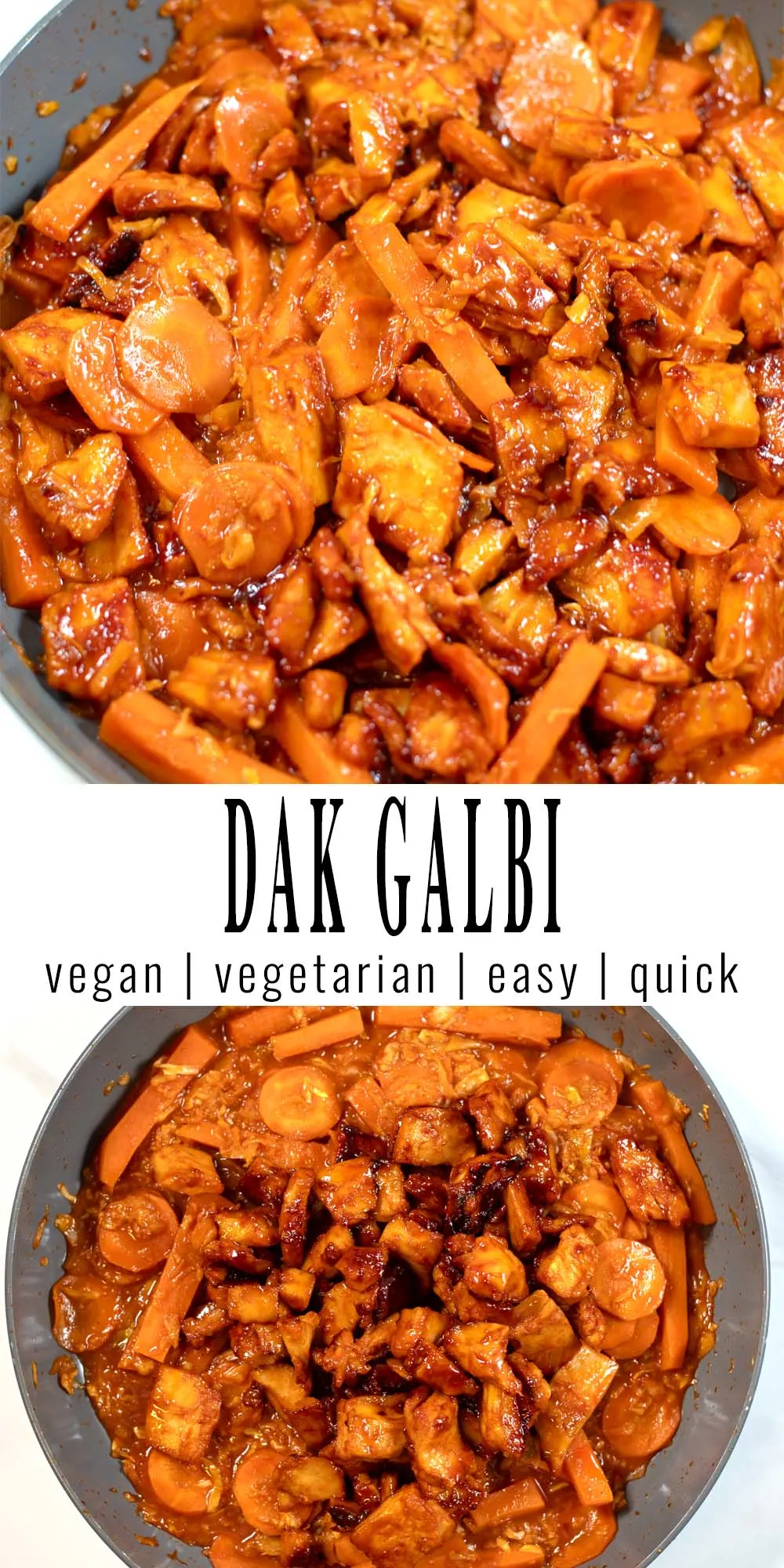
If you love this homemade Dak Galbi recipe, share with a tag on Instagram and Facebook.
Enjoy, Florian.
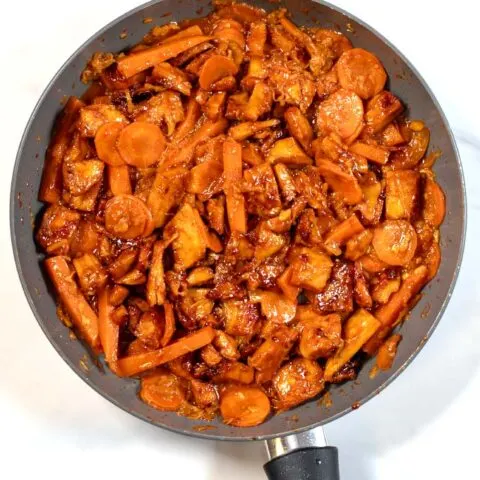
Easy Dak Galbi Recipe with Spicy Korean Chicken
This homemade Dak Galbi recipe is inspired by the vibrant streets of Korea with a tantalizing and spicy stir-fried chicken dish. Bursting with bold flavors and an array of colorful vegetables, this savory delight is a perfect fusion of sweet, savory, and spicy notes. As you savor each tender bite of marinated chicken, you'll experience the authentic taste of Dak Galbi right in the comfort of your own kitchen, bringing the spirit of Korean street food to your dining table.
Ingredients
- 1 cup sweet potatoes, cut
- 2 tbsp vegetable oil, divided
- 1/3 cup cabbage
- 10 oz vegan chicken
- 1/2 cup carrots, sliced
- salt, black pepper to taste
For the Sauce + marinade:
- 2 tbsp Gochujang paste
- 2 tbsp coconut milk
- 2 tbsp brown sugar
- 3 cloves garlic
- 3 tbsp soy sauce
- 1 tsp ginger
- 3 tbsp rice vinegar
Instructions

Marinate the chicken:
- In a bowl, combine gochujang paste, soy sauce, rice vinegar, sugar, garlic, ginger, and coconut milk. Mix until well combined.

- Add the chicken to the marinade and let it marinate for 10 minutes.
Cook the chicken:
- Heat a large skillet with 1 tablespoon of vegetable oil. Add the chicken (don't discard the remaining sauce) and cook for about 5 minutes. The cooking time will depend on the package directions.

- Remove the chicken from the pan.
Cook the vegetables:
- In the same pan, add another tablespoon of oil, sweet potatoes, carrots, cabbage, and the remaining sauce. Cook for 15 minutes.

- Add the chicken back to the pan and cook for an additional 2 minutes.

- Serve and enjoy!

Nutrition Information:
Yield: 4 Serving Size: 1 cupAmount Per Serving: Calories: 348Total Fat: 11gSaturated Fat: 5gTrans Fat: 0gUnsaturated Fat: 4gCholesterol: 0mgSodium: 890mgCarbohydrates: 27gFiber: 3gSugar: 8gProtein: 20g